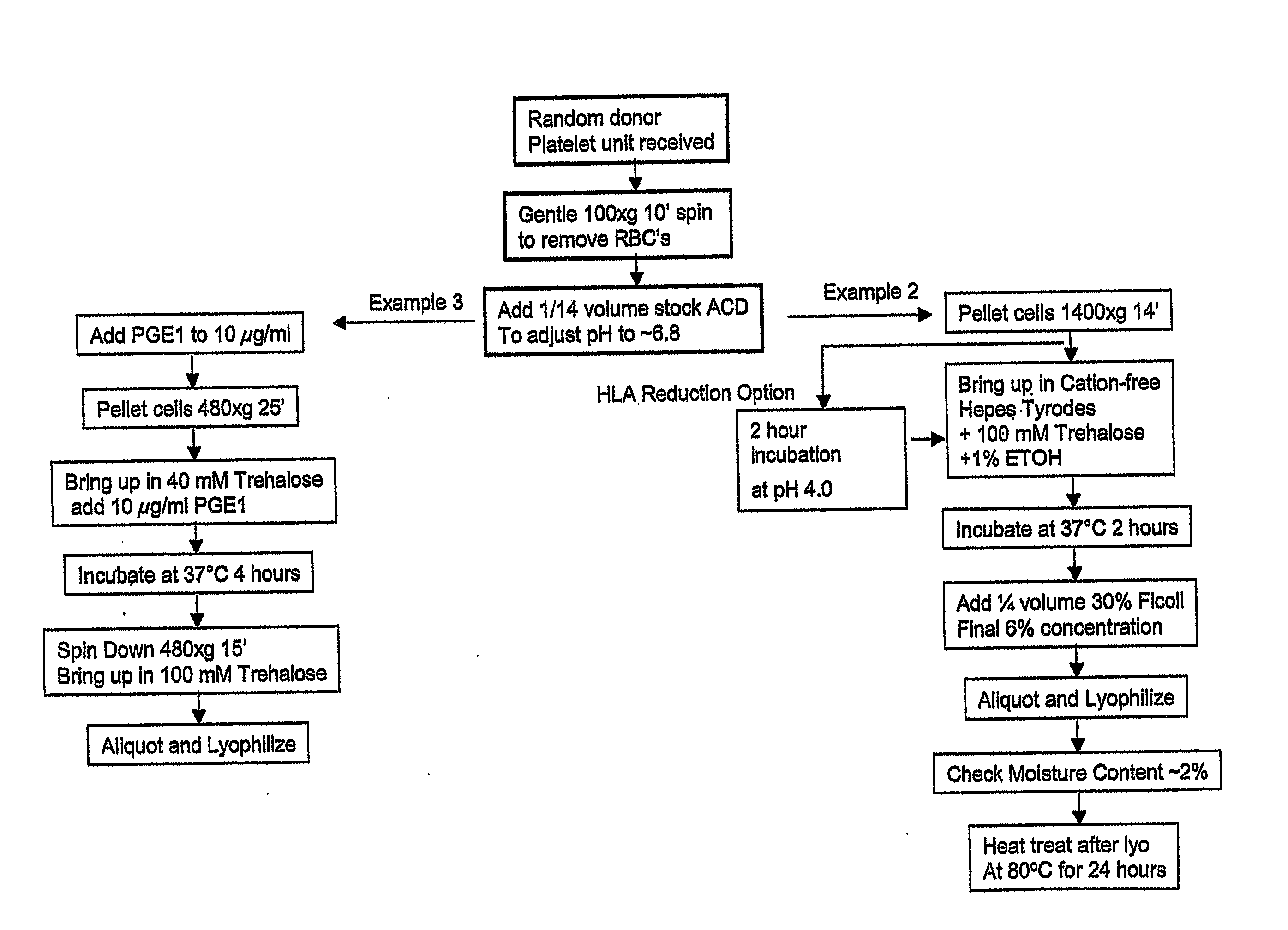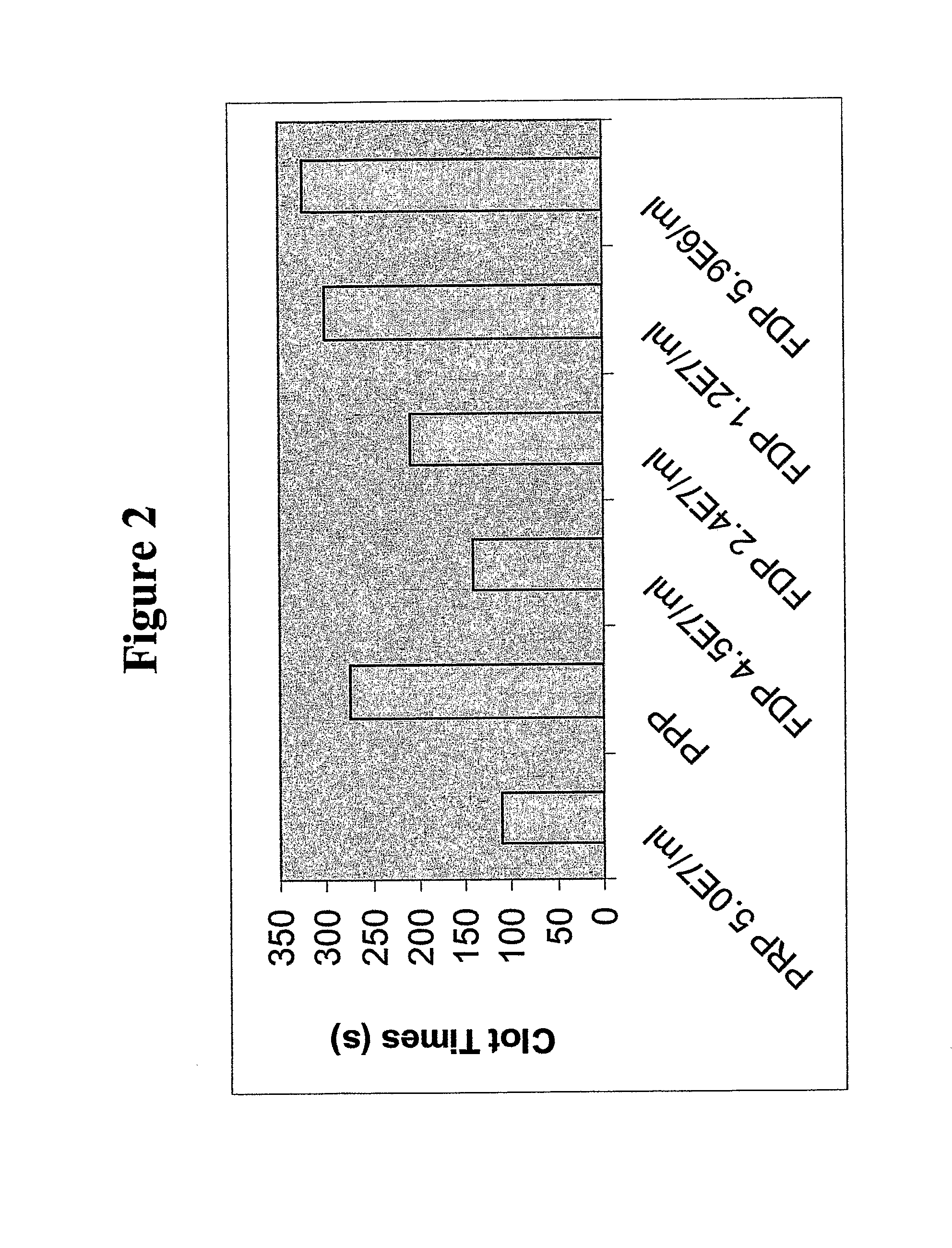Methods for Preparing Freeze-Dried Platelets, Compositions Comprising Freeze-Dried Platelets, and Methods of Use
a technology of platelets and compositions, applied in the field of platelets and platelet compositions, can solve the problems of large volume/mass of dense red blood cells migrating to the bottom of the centrifuge tube, blood loss, allergic reactions, etc., and achieve the effects of enhancing the efficacy of the latter, accelerating the efficacy of procoagulant drugs, and saving costs
- Summary
- Abstract
- Description
- Claims
- Application Information
AI Technical Summary
Benefits of technology
Problems solved by technology
Method used
Image
Examples
example 1
Preparation of Freeze-Dried Platelets
[0251] A method of preparing freeze-dried platelets was developed to provide platelets having a long shelf-life and suitable characteristics upon rehydration. The method was found to provide freeze-dried platelets, and platelets reconstituted from those freeze-dried platelets, with advantageous properties for in vitro studies and in vivo therapeutic applications.
[0252] The method of preparing freeze-dried platelets comprised the following:
[0253] An initial saccharide-loading process included:
[0254] all solutions, buffers, equipment, etc. were checked to ensure that each was at or near room temperature to minimize adverse effects of cold temperatures on the platelets;
[0255] platelet-rich plasma (PRP) was obtained;
[0256] the suitability of the platelets was checked by checking swirling—if no swirling was noticed, the platelets were rejected;
[0257] the pH of the platelet composition was checked and samples having a pH lower than 6.2 were rejec...
example 2
Preparation of Freeze-Dried Platelets
[0274] A second method of preparing freeze-dried platelets was developed to provide platelets having a long shelf-life and suitable characteristics upon rehydration. The method was found to provide freeze-dried platelets, and platelets reconstituted from those freeze-dried platelets, with highly advantageous properties for in vitro studies and in vivo therapeutic applications.
[0275] The method of preparing freeze-dried platelets comprised the following:
[0276] An initial saccharide-loading process included:
[0277] all solutions, buffers, equipment, etc. were checked to ensure that each was at or more room temperature to minimize adverse effects of cold temperatures on the platelets;
[0278] platelet-rich plasma (PRP) was obtained;
[0279] the suitability of the platelets was checked by checking swirling—if no swirling was noticed, the platelets were rejected;
[0280] the pH of the platelet composition was checked and samples having a pH lower than...
example 3
Preparation of a Composition of the Invention
[0300] Non-autologous platelets were purchased from BRT Labs (Baltimore, Md.) and used within 4-24 hours of draw. Platelet Rich Plasma (PRP) was obtained by low speed centrifugation (135×g) for 15 minutes to remove red blood cells. The centrifuged PRP (without red blood cells) was acidified to pH 6.5 by adding 1 / 14 volumes of ACD (acid citrate dextrose) and then pelleted by centrifuge at 1000×g for 10 minutes. The platelet-poor plasma was decanted, and the packed cells were drained over a paper towel to remove plasma proteins. Alternatively, residual liquid was removed by aspiration with a plastic transfer pipette. The platelets were resuspended in 1 ml of Cation-Free Tyrodes Buffer containing 50 mM of trehalose at pH 6.8, and the platelet concentration was adjusted to ˜1.0×109 / ml. The mixture was incubated for 2 hours at 37° C., mixing once each half hour. Finally, the albumin (BSA) concentration was adjusted to 5% (w / v) of the platelet...
PUM
 Login to View More
Login to View More Abstract
Description
Claims
Application Information
 Login to View More
Login to View More - R&D
- Intellectual Property
- Life Sciences
- Materials
- Tech Scout
- Unparalleled Data Quality
- Higher Quality Content
- 60% Fewer Hallucinations
Browse by: Latest US Patents, China's latest patents, Technical Efficacy Thesaurus, Application Domain, Technology Topic, Popular Technical Reports.
© 2025 PatSnap. All rights reserved.Legal|Privacy policy|Modern Slavery Act Transparency Statement|Sitemap|About US| Contact US: help@patsnap.com



